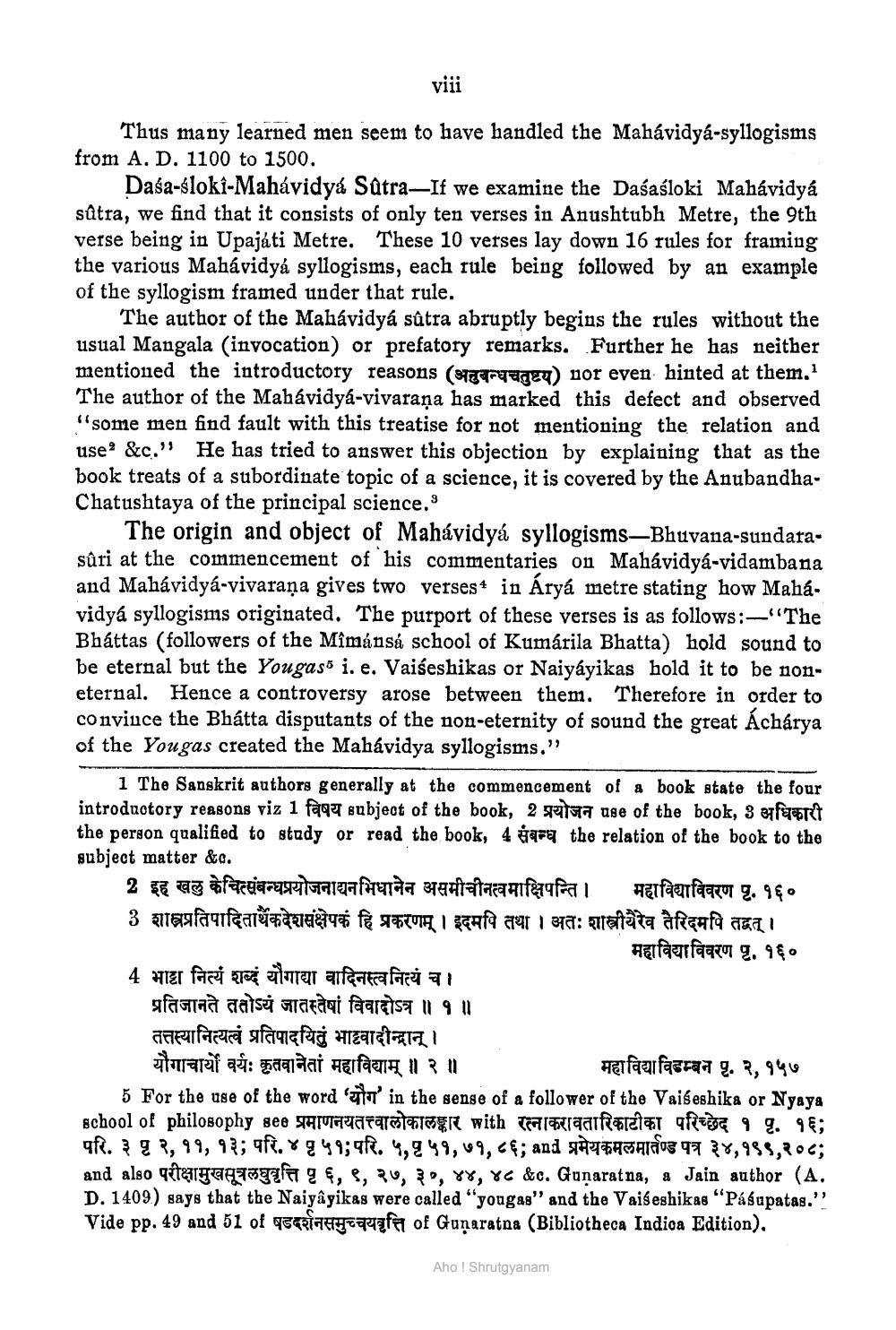________________
viii
Thus many learned men seem to have handled the Mahavidyá-syllogisms from A. D. 1100 to 1500.
Dasa-sloki-Mahavidya Sûtra-If we examine the Daśaśloki Mahavidyá sûtra, we find that it consists of only ten verses in Anushtubh Metre, the 9th verse being in Upajáti Metre. These 10 verses lay down 16 rules for framing the various Mahavidyá syllogisms, each rule being followed by an example of the syllogism framed under that rule.
The author of the Mahavidyá sûtra abruptly begins the rules without the usual Mangala (invocation) or prefatory remarks. Further he has neither mentioned the introductory reasons (e) nor even hinted at them.1 The author of the Mahavidya-vivarana has marked this defect and observed "some men find fault with this treatise for not mentioning the relation and use &c." He has tried to answer this objection by explaining that as the book treats of a subordinate topic of a science, it is covered by the AnubandhaChatushtaya of the principal science."
The origin and object of Mahavidyá syllogisms-Bhuvana-sundarasûri at the commencement of his commentaries on Mahavidyá-vidambana and Mahavidya-vivarana gives two verses in Áryá metre stating how Mahávidyá syllogisms originated. The purport of these verses is as follows:-"The Bháttas (followers of the Mîmánsá school of Kumárila Bhatta) hold sound to be eternal but the Yougas" i. e. Vaiśeshikas or Naiyáyikas hold it to be noneternal. Hence a controversy arose between them. Therefore in order to convince the Bhátta disputants of the non-eternity of sound the great Áchárya of the Yougas created the Mahavidya syllogisms."
1 The Sanskrit authors generally at the commencement of a book state the four introductory reasons viz 1 विषय subject of the book, 2 प्रयोजन use of the book, 3 अधिकारी the person qualified to study or read the book, 4 the relation of the book to the subject matter &c.
2 इह खलु केचित्संबन्धप्रयोजनाद्यनभिधानेन असमीचीनत्वमाक्षिपन्ति ।
महाविद्याविवरण पृ. १६०
3 शास्त्रप्रतिपादितार्थैकदेशसंक्षेपकं हि प्रकरणम् । इदमपि तथा । अतः शास्त्रीयैरेव तैरिदमपि तद्वत् । महाविद्या विवरण पृ. १६०
4 भाट्टा नित्यं शब्द योगाद्या वादिनस्त्वनित्यं च । प्रतिजानते ततोऽयं जातस्तेषां विवादोऽत्र ॥ १॥ तत्तस्यानित्यत्वं प्रतिपादयितुं भाट्टवादीन्द्रान् । योगाचार्यों वर्यः कृतवानेतां महाविद्याम् ॥ २ ॥
महाविद्या विडम्बन पृ. २, १५७
5 For the use of the word '' in the sense of a follower of the Vaiseshika or Nyaya school of philosophy see प्रमाणनयतत्त्वालोकालङ्कार with रत्नाकरावतारिकाटीका परिच्छेद १ पृ. १६; परि. ३ पृ २, ११, १३; परि. ४५१; परि. ५, १५१, ७१, ८६; and प्रमेयकमलमार्तण्ड पत्र ३४, १९९,२०८; and also qûyogafa 9 €, e, zv, 3, xx, xe &c. Gunaratna, a Jain author (A. D. 1409) says that the Naiyâyikas were called "yougas" and the Vaiseshikas "Pasupatas."' Vide pp. 49 and 51 of qecinayzappfe of Gunaratna (Bibliotheca Indica Edition).
Aho! Shrutgyanam




